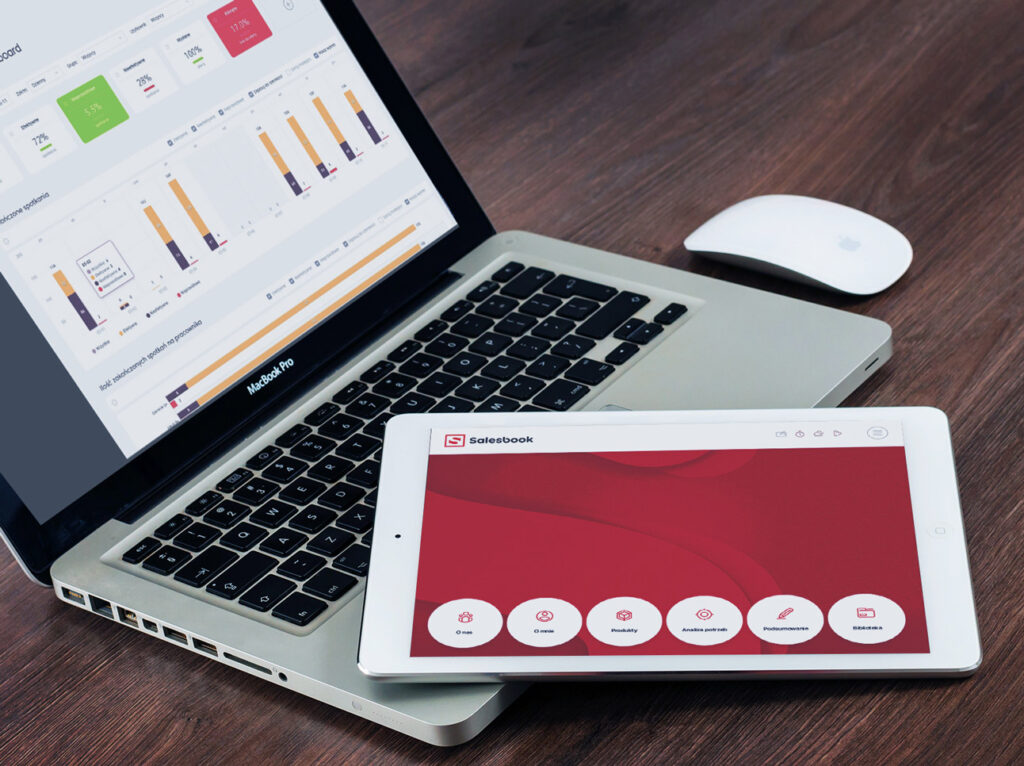Salesbook + CRM = Sales

According to surveys, as many as 57% of users are not satisfied with the CRM system. If we look from the perspective of commercial companies, this percentage is even higher. Browsing the Internet, we will find numerous statistics and articles about the disturbing titles “How to implement CRM” or “13 errors in the implementation of CRM”. What is the reason for this state of affairs? I will try to answer that in the article below.
Management postulate: we must have a system that will give us information about the work of sales teams.
The managerial staff always formulates this demand and this is the initiator of the purchase and implementation of the CRM system. It never flows from sellers. Let’s look at the information needed by the management:
– How many meetings did our sales representatives have? With who and in what place?
– What is the contract amount? What is the probability of its closure?
– At what stage of the conversations are our sellers? What has been determined?
– How are the leads being used? What is the quality of the talks held?
And although this demand cannot be met, it is no secret that we often make the simple assumption that:
Bad information is better than none
The implementation of a CRM system is a hard work, not just in terms of technical aspects, but mainly because of the fact that that employees do not see its real value. It stretches in time, and its maintenance is associated with great effort and costs. Sellers do not see any benefit from the implementation of the CRM system, because it is an additional burden for them without any benefits. How can the collected information help the seller then? For example, “With whom and in what place did he meet?” – after all, the salesperson knows it, he himself had a meeting and was selling!
Sellers’ postulate: we want to have a tool that will help us in sales (in conversation and argumentation), which will prepare an offer and automatically report everything to CRM.
The problem – as can be easily seen – results from the discrepancy between the expectations of salespeople and management. The reality looks bad, because after the implementation of the CRM system the sales motivation paradoxically decreases, and as a consequence sales itself. Traders work less efficiently and the information from the system is far from expectations.
How much time a day does the salesman work? 10 hours on average!
– 1h – preparation,
– 5h – work with the client,
– 1h – preparation of offers,
– 1h – e-mail and telephones,
– 1h – “fire fighting”,
– 1h – reporting to CRM.
Despite the amount of time spent on work, it turns out that 50% of the sales team has a problem delivering results. This is confirmed by a report published by probably the most recognizable of the CRM systems – Salesforce – in which 57% of sellers expected that they would not meet the assumed budget in 2018.
How does the salesman work with the CRM system?
We can distinguish 3 scenarios:
1) complements the CRM after each meeting,
2) works all day, and finally completes the CRM,
3) supplements the CRM when he has time (e.g. delegation work).
In the course of my work as a seller of ERP systems most of the meetings took place in Warsaw. The trip on the Rzeszów – Warsaw route is 370 km, which gives about 4.5 hours of driving, hence: the trip around 5-6 am, first meeting at 12, next at 15, end of work at 17, dinner and return home around 23-24 (or overnight at the hotel).
At the meeting usually a dozen people or so (such a specificity of work) and many threads run in parallel (from business to technical). In the morning work in the company – assigning tasks, valuations, logistics, preparation of offers, outstanding telephones from other commercial projects, “fire fighting”, and at the end of the day supplementing CRM (with the minimum required by the company).
The biggest disadvantage of the CRM system is its declarative nature!
This means that the information depends only on the trader and his condition, which has a key impact on the quality of the data. Not only that, almost every entry can be defended against the management – unless it will be an obvious fraud.
On the one hand, therefore, we have wishful expectations of the managerial staff, and on the other hand, additional working hours of sales representatives. And here begins the fight: “not entering data into CRM – no bonus” or “for entering data into CRM – reward”.
Effects are easy to imagine. At the very end, in an act of desperation, the management introduces facilitations and the seller only has to click one of four statuses: “opening”, “offer”, “contract”, “failure”.
This is a devaluation of the CRM class tool and lack of implementation of the postulate of the management staff.
Salesbook + CRM = Sales
Is there a solution? Yes, we must give sellers a tool to help them to sell. A tool that will not be another system to complement, but a tool for the everyday work of a sales representative – facilitating argumentation, simulation, automatically preparing the offer and sending it to the client, and in addition automatically supplementing all internal systems, including CRM. Only then CRM will cease to be the enemy of the seller, and will become his natural ally.
What can we gain by providing Salesbook to the sellers?
– sales increase by over 33%,
– salesmen satisfaction,
– reliable management information.
What does working with a Salesbook look like?
Each vendor has a tablet application, there is no brochure or notebook sheets (they may be, but they do not recommend). In this moment there are often voices “yet, this cannot go right”. Well, it can. This is exactly how Prudential works from the beginning of its operations in Poland. The company in which over 2,000 sellers work and who generate all their income “from tablets”.
During the meeting, the seller works on the tablet with the customer (he has a set of tools necessary to carry out the sales process).After the meeting, further steps are planned with the client, and just a few seconds after the meeting, the client receives an e-mail offer developed during the meeting. At the same time, the CRM system is automatically updated.
Sellers do not therefore do anything else but go to the next meeting. Thanks to the Salesbook application, we realize the demands of two groups: management staff and sales forces.
Table of Contents







